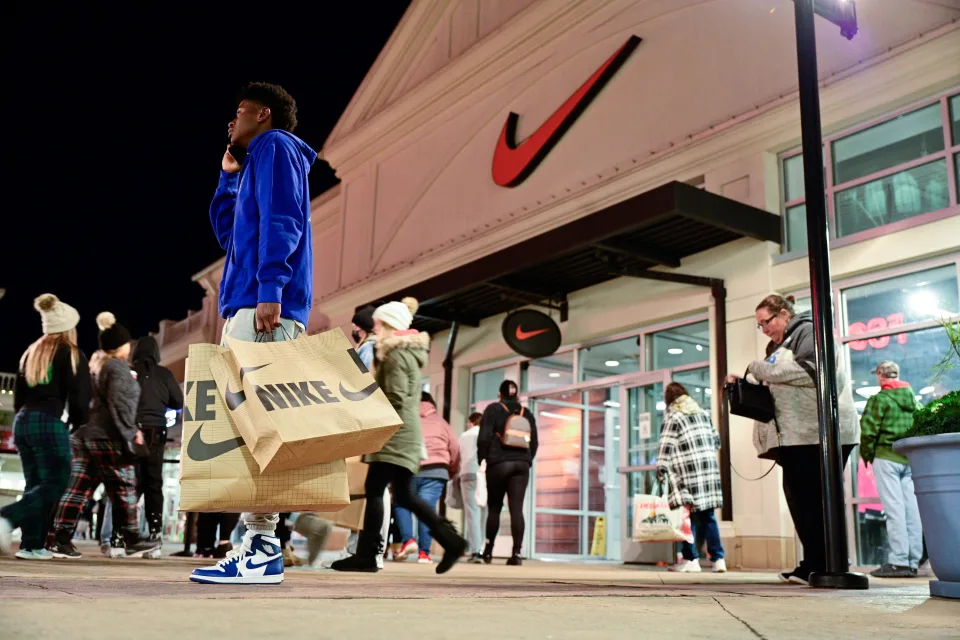Nike (NKE) told investors on Tuesday it believes it has reached the peak of its inventory glut.
The company’s inventory decreased one percentage point from the prior quarter, but sales rose by a better-than-expected 17% year-over-year, driven by markdowns on that excess product.
“We’re executing in the areas we spoke to 90 days ago as we take decisive action to clear excess inventory,” Nike CEO and president John Donahoe told investors on Tuesday. “We believe the inventory peak is behind us. The actions we’re taking in the marketplace are working.”
Nike’s revenue hits $13.32 billion in its fiscal second quarter, beating Wall Street estimates of $12.6 billion. Nike’s reported adjusted earnings of $0.85 per share, marking the first year-over-year increase in four quarters, and topped expectations for $0.65.
The surge in sales overshadowed the company’s lingering $9.3 billion inventory issue and shrinking gross margins compared to the same quarter last year.
Shares of Nike gained over 12% on Wednesday. Nike stock is still down 30% this year.
“The metrics through and through kind of beat expectations,” Barclays Consumer Discretionary Analyst Adrienne Yih told Yahoo Finance Live (video above). “The expectations were high and the only one that missed is that inventory number. I think the question mark is how does that bode for gross margin guidance for the next quarter?”
Nike executives noted on Tuesday’s quarterly earnings call that “unfavorable changes” in exchange rates, higher markdowns to offset inventory, and elevated freight and logistics costs have weighed on margins.
Nike’s 42.9 percent gross margin beat Wall Street estimates but still lagged the same quarter last year by 300 basis points. The retailer’s margins have now shrunk for each of the last three quarters.
Headwinds for margins are expected to subside in the short-term, with Nike forecasting continued markdowns for consumers moving forward as the company emphasizes a “healthy inventory position by the end of this fiscal year,” according to Donahoe.
Nike’s better than expected results were received positively by investors following a weaker than expected retail sales report last week and data indicating declining consumer spending as investors brace for a downturn in 2023.
Direct-to-consumer sales of $5.4 billion fell about $25 million short of Wall Street expectations for the most recent quarter. Yih argues that miss was acceptable, considering Nike’s 19% growth year-over-year in wholesale revenue.
But Nike executives believe that beyond positive wholesale growth and offloading inventory, the yearly increase in direct-to-consumer sales, which rose 16% year-over-year, continues to be a key driver to Nike’s growth story.
“We continue to see strong levels of full price realization in footwear which continue to give us confidence in our most important product franchises, the stories that we continue to tell to refresh and make them relevant, as well as the new products that we continue to bring to market on a seasonal basis,” Nike CFO Matt Friend said.
Greater China revenue hit $1.79 in the second quarter, down 3% from a year ago. After revenue declines of 16% and 19% over the prior two quarter, respectively, the second quarter suggests a potential turning of the corner in one of Nike’s largest markets.
Yih noted thematically investors are “looking for China reopening stories,” and there might be one brewing at Nike.
“We’re taking a very careful approach, we have a lot of empathy for the consumers, in terms of what they’re going through in that environment,” Friend said, regarding the China market.
“And we’re watching traffic closely, but having inventory cleaned at the end of the second quarter really gives us a position of strength to deal with whatever uncertainties that are in front of us.”

